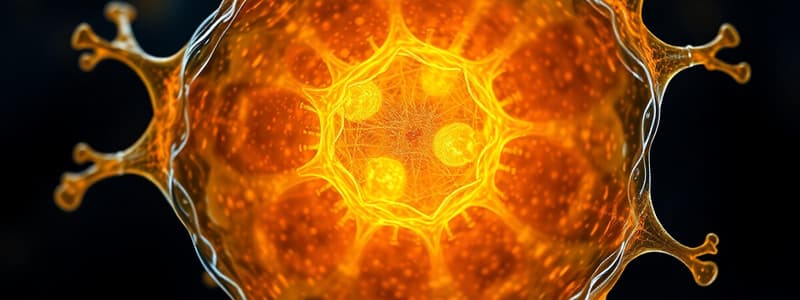Podcast
Questions and Answers
What is the primary function of the nuclear envelope?
What is the primary function of the nuclear envelope?
- To bind the cell membrane
- To store genetic material
- To regulate substance passage (correct)
- To facilitate cellular respiration
Which of the following statements accurately describes a function of the nucleus?
Which of the following statements accurately describes a function of the nucleus?
- It produces energy in the form of ATP.
- It regulates the cell's peripheral activities.
- It directs metabolic activities including protein synthesis. (correct)
- It synthesizes glucose through photosynthesis.
What is the structure of the plasma membrane primarily composed of?
What is the structure of the plasma membrane primarily composed of?
- Double layer of phospholipids with embedded proteins (correct)
- Rigid structure of cellulose
- Single-layer of phospholipids
- Carbohydrates and proteins only
Which of the following correctly describes the nature of the plasma membrane?
Which of the following correctly describes the nature of the plasma membrane?
How does the nuclear envelope connect with the endoplasmic reticulum?
How does the nuclear envelope connect with the endoplasmic reticulum?
What is the orientation of phospholipids in the plasma membrane?
What is the orientation of phospholipids in the plasma membrane?
Which function do membrane proteins NOT serve?
Which function do membrane proteins NOT serve?
What role do carbohydrates play in cell membranes?
What role do carbohydrates play in cell membranes?
What is primarily found in the cytoplasm of a cell?
What is primarily found in the cytoplasm of a cell?
Which statement about membrane structure is incorrect?
Which statement about membrane structure is incorrect?
What is the smallest functional unit of the body?
What is the smallest functional unit of the body?
Which organelle is known as the administrative center of the cell?
Which organelle is known as the administrative center of the cell?
What distinguishes multicellular organisms like humans from unicellular organisms?
What distinguishes multicellular organisms like humans from unicellular organisms?
Which of the following processes involves cell division?
Which of the following processes involves cell division?
Which of these components is not found in red blood cells?
Which of these components is not found in red blood cells?
Which cell structure is primarily responsible for protein synthesis?
Which cell structure is primarily responsible for protein synthesis?
What is the role of the Golgi apparatus in the cell?
What is the role of the Golgi apparatus in the cell?
What structure is responsible for the movement of substances within the cytoplasm?
What structure is responsible for the movement of substances within the cytoplasm?
What is the main function of lysosomes within a cell?
What is the main function of lysosomes within a cell?
How do lysosomes prevent damage to the cell?
How do lysosomes prevent damage to the cell?
Which process involves the lysosomal degradation of a cell's own components?
Which process involves the lysosomal degradation of a cell's own components?
What type of cells are typically abundant in lysosomes due to their phagocytic activity?
What type of cells are typically abundant in lysosomes due to their phagocytic activity?
What is released by lysosomes to aid in breaking down other cells?
What is released by lysosomes to aid in breaking down other cells?
What is the direction of movement for diffusion?
What is the direction of movement for diffusion?
What role does ATP play in active transport?
What role does ATP play in active transport?
Which process is primarily used for the intake of liquids by cells?
Which process is primarily used for the intake of liquids by cells?
What characterizes osmosis as a process?
What characterizes osmosis as a process?
What best describes phagocytosis?
What best describes phagocytosis?
Which of the following statements about hyperplasia is true?
Which of the following statements about hyperplasia is true?
Endocytosis encompasses which of the following methods?
Endocytosis encompasses which of the following methods?
What is the primary function of the sodium-potassium pump?
What is the primary function of the sodium-potassium pump?
Flashcards are hidden until you start studying
Study Notes
Cell Structure & Function
- The cell is the smallest functional unit of the body
- All organisms are made of cells
- Cells carry out all vital chemical processes
- Humans are multicellular
- Cells are differentiated and adapted for different tasks
- Groups of cells form tissues
- Groups of tissues form organs
- Groups of organs form systems
The Nucleus
- The nucleus is a highly specialized organelle that serves as the information processor and administrative center of the cell
- One nucleus per cell usually
- Skeletal muscle and other cells have several
- Missing from erythrocytes (red blood cells)
- Largest feature in a cell
- Bound by a double membrane, the nuclear envelope – the outer layer being continuous with the Endoplasmic Reticulum (ER)
- Pores in the membrane allow the passage of substances
- Stores genetic material (DNA)
- Directs all metabolic activities of the cell including growth, metabolism, protein synthesis, and reproduction (cell division)
- Involved in cell division
- Instructs the synthesis of proteins/ribosomes & RNA
The Plasma Membrane
- Partially permeable
- Made up of two layers
- Double layer (bilayer) of lipids mostly phospholipids
- Phospholipids are hydrophilic ("water-loving") at their phosphate ends – facing outwards, and hydrophobic ("water-fearing") along their lipid tail regions – orientated inwards
- Some proteins are embedded in the bilayer, while others attach to the surface
- Many proteins play a part in the selective transport of substances across the membrane
- Others act as surface receptors for substances such as hormones, or act as enzymes
Functions of the Plasma Membrane & Its Proteins
- Contains cell contents
- Regulate transport in and out of the cell
- Provide immunological identity
- Act as receptors (recognition sites) e.g. for hormones
- Allows directed cell or organelle motility
Cytoplasm
- Gelatinous, semi-transparent fluid that fills most cells and is where metabolic reactions occur
- Mainly water, with many solutes including glucose, proteins & ions
- Contains many vital cellular chemicals
Lysosomes
- A secretory vesicle formed by the Golgi apparatus
- Contain enzymes responsible for degrading proteins & membranes in the cell
- Aids degradation of materials ingested by the cell – due to hydrolytic (digestive) enzymes
- Kept apart from the cell otherwise they would destroy the contents of the cell
- Abundant in cells with phagocytic activity e.g. leucocytes
Lysosomes Function Continued...
- Digest materials which the cell consumed from the environment e.g. bacteria
- Autophagy: A process involving the degradation of a cell's own components through the lysosomal machinery.
- Autolysis: The destruction of a cell through the action of its own enzymes.
- They release enzymes outside the cell (exocytosis) in order to break down other cells
Diffusion
- The process by which a substance moves from a region of high concentration to a region of low concentration
- Rate is variable: Concentration gradient, distance, the size of area, structure in path, & size of molecule
Osmosis
- The passage of water down its concentration gradient towards equilibrium across a semi-permanent membrane
- Occurs when solute molecules are too large to pass through the pores in the membrane by diffusion
Active Transport
- Transport of substances up their concentration gradient i.e. from a lower to a higher concentration.
- Chemical energy (ATP) drives protein molecules in the membrane that transport substances across the membrane in either direction.
- For example, the sodium-potassium pump maintains homeostasis of electrolytes sodium and potassium.
Phagocytosis
- The process by which the cell can obtain particles which are too large to be absorbed by diffusion or active transport.
Pinocytosis
- ‘Cell drinking’ is very similar to phagocytosis except vesicles are produced called ‘pinocytotic vesicles’.
- Used for intake of liquids rather than solids.
- Both pinocytosis & phagocytosis are methods by which materials are taken into the cell in bulk - ENDOCYTOSIS.
- The reverse process materials are removed from the cell e.g. waste products – EXOCYTOSIS.
Abnormal Cell Growth
- Hyperplasia: A term referring to the proliferation of cells within an organ or tissue beyond that which is ordinarily seen i.e. constant cell division.
Studying That Suits You
Use AI to generate personalized quizzes and flashcards to suit your learning preferences.




